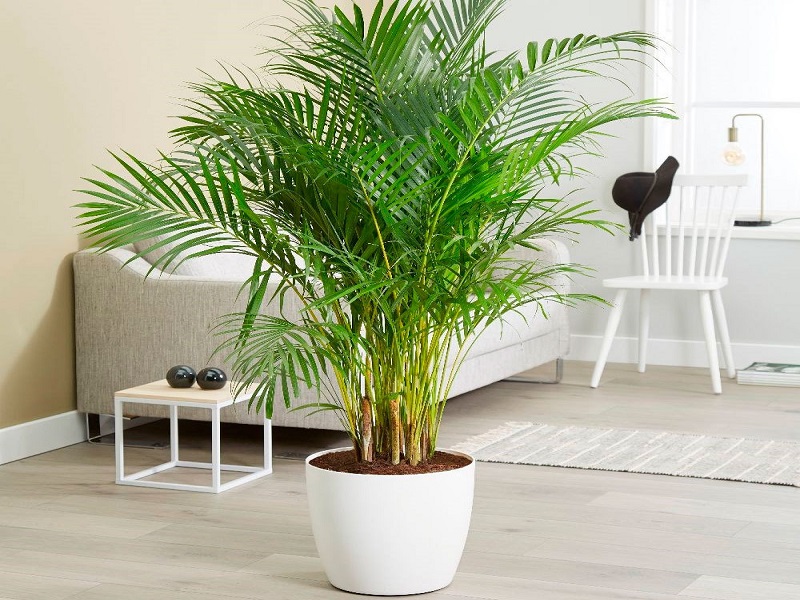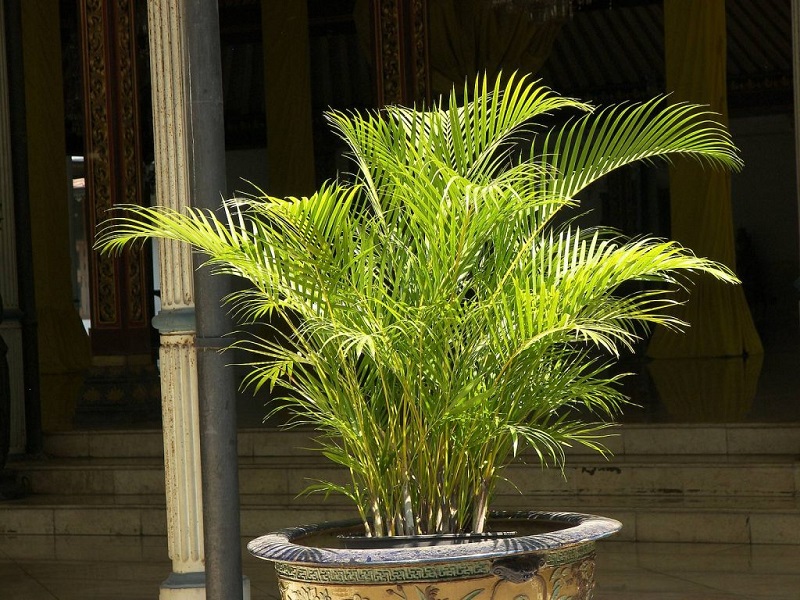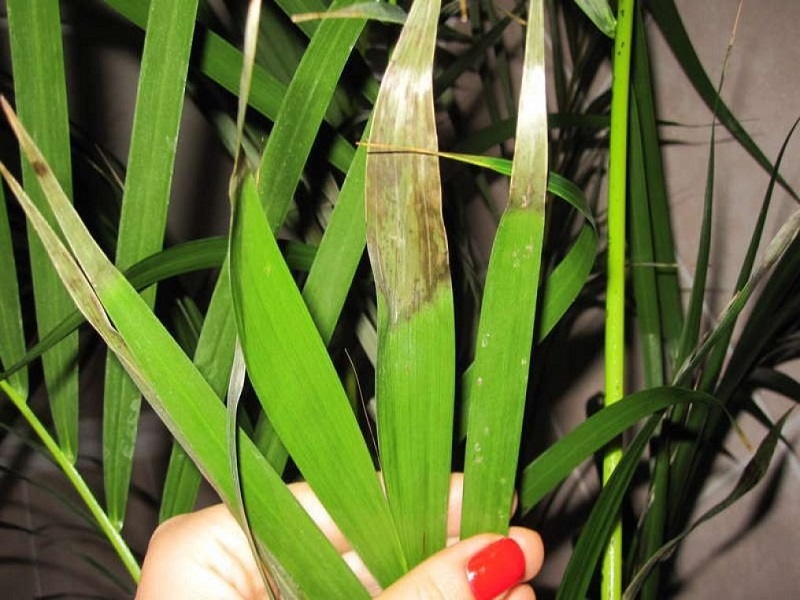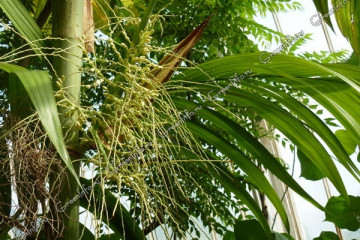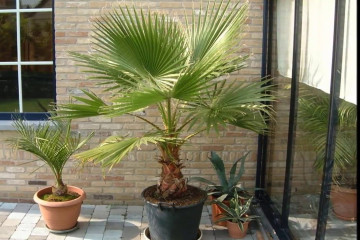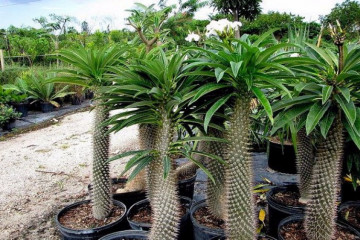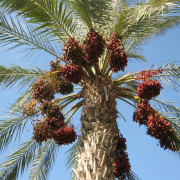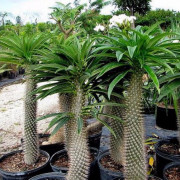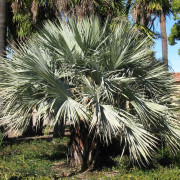Chrysalidocarpus - home care
Content:
- What does chrysalidocarpus look like, which family does it belong to
- The main types of chrysalidocarpus
- Features of caring for chrysalidocarpus at home
- The nuances of caring for a plant in winter, dormant period
- When and how it blooms, flowering periods
- How the palm tree reproduces
- Plant transplant when buying or planting
- Possible growing problems
Chrysalidocarpus has gained great popularity among florists. Home care for a tropical palm tree requires minimal. You need to take care of sufficient lighting, provide regular watering. The flower will thank for this with a beautiful and healthy look of its large exotic leaves.
What does chrysalidocarpus look like, which family does it belong to
Chrysalidocarpus was brought from distant Madagascar, and the Comoros is considered to be its homeland. Belongs to the Arecaceae family, of which there are more than 2.5 thousand species. This palm tree is very moisture-loving, moreover, it tries to extract water not only from the soil, but also from the air.
As for the structure, there are plants that outwardly resemble a bush, since there is a strong branching at the base. There are also single-barreled representatives.
In its natural environment, a palm tree can reach 10 meters in height, in a year it grows only 30 cm, but it gains mass in breadth, due to the appearance of side shoots.
The main types of chrysalidocarpus
There are about 20 species of chrysalidocarpus palm, but not all varieties are suitable for home cultivation. In an apartment, a tropical culture grows up to 3 meters. Each variety has its own structure, there are plants with one trunk, and there are plants with several stems.
Chrysalidocarpus yellowish (Chrysalidocarpus lutescens)
This representative is also known as chrysalidocarpus dipsis, chrysalidocarpus lutescens. The palm tree stands out from the rest of the tropical vegetation with its yellow-orange stems, which branch very densely at the base. The foliage is colored the same color as the shoots. The frond grows up to 2 m long and one wide.
The dark scales on the petioles disappear as the Tropican matures. In the natural environment, yellowish fruits can form on a palm tree of this variety, but berries can be found extremely rarely in home floriculture.
Chrysalidocarpus madagascariensis (Chrysalidocarpus madagascariensis)
Single-stemmed evergreen palm, which reaches about 30 cm in diameter. Rings are well traced on the stem. An adult plant can grow up to 8 m in height.
The leaf plate of chrysalidocarpus is smooth, its length varies within 45 cm, and its width is 2-3 cm. Branched inflorescences are located in the leaf axils.
As for the conditions of detention, the tropical culture prefers a warm climate, but the cold can negatively affect its growth and development.
Features of caring for chrysalidocarpus at home
Before starting a tropical plant, you need to figure out what kind of chrysalidocarpus care at home requires. What exactly does a palm tree need for normal growth and development?
Temperature and lighting
This representative of the Arecs loves bright light, therefore it is recommended to place a flowerpot with a palm tree on the southern or southeastern windowsill. In addition, the plant must be provided with a long daylight hours, it must be at least 12 hours. In winter, you will have to install additional lighting.
In order for indoor vegetation to develop well and the crown to be symmetrical, it is required to turn the pot over from time to time.
It is also necessary to maintain the temperature regime, the indicators should be as follows:
- summer - 22-25 degrees;
- winter - 18-22 degrees.
In addition, you need to periodically ventilate the home, but there should be no drafts, this can affect the health of the room palm.
Watering and humidity
Chrysalidocarpus loves a humid climate, this must be taken into account when growing. The bush needs to be sprayed regularly, this is especially important in the summer. The water should be well settled, soft and not very cold.
Water the substrate abundantly, you need to make sure that it is always moist. Otherwise, the plant will begin to dry, and the leaves will curl and fall off. In winter, watering activities must be approached carefully, do not allow transfusions, this can harm the roots.
Soil preparation and feeding features
Chrysalidocarpus makes special demands on the quality of the substrate, the plant needs a fertile and light soil with a neutral reaction. But alkaline soils are not suitable for him. For transplantation, you can purchase ready-made compounds that are designed for palm trees. You can also make the mixture yourself, for this you need to prepare:
- leafy land;
- humus;
- coarse sand;
- peat;
- turf.
As for feeding, areca is fertilized throughout the year. In spring and summer, specialized complexes or universal mineral fertilizers are applied. The procedure is carried out twice a month. In winter, they are fed once a month.
The nuances of caring for a plant in winter, dormant period
Areca leaves for rest when the time of daylight decreases, so you can artificially introduce it into the resting period.
As for care, it is necessary to reduce the number and volume of irrigation procedures, to abandon spraying and fertilization.
When and how it blooms, flowering periods
The palm tree begins to bloom in the last days of May. In the leaf sinus, paniculate inflorescences of a yellow hue appear. Although in the conditions of an apartment you can not wait for it.
After the buds wilt, berries are formed in their place, and seeds are extracted from them for further reproduction.
How the palm tree reproduces
Areca reproduces well, so you can do the procedure yourself. Most often, root suckers are used, they take root faster. With the help of seeds, you can also get a young palm tree, but you have to spend time and effort.
Seed propagation
Most often, growers try to grow chrysalidocarpus lutescens from seeds. True, this is a long process and is not always justified, since the germination of the planting material is average. Landing is carried out in several stages, namely:
- soak seeds in warm water;
- laid on the surface of the nutrient substrate, which is pre-moistened;
- cover the container with plastic wrap;
- spray and ventilate before emergence.
Transplanting seedlings into a separate pot is carried out after two adult leaves are formed on the seedling.
Propagation by basal processes
If a vegetative method is used, then it is carried out in early spring. Children can only be obtained from an adult flower; the processes should be cut off with a sharp knife, making an oblique cut. After that, you need to sprinkle the wound with coal.
The resulting shoot is placed in pre-prepared soil, moistened and harvested in partial shade. Additionally covered with a plastic cup, it will create a greenhouse effect. You also need to monitor the temperature, the indicator should not rise above 29 degrees, and fall below 26.
Plant transplant when buying or planting
Areca chryse is extremely difficult to tolerate a transplant, so the procedure is carried out only in extreme cases. Do not disturb the plant once again.
An adult bush is transplanted no more than once every 4 years, at which time the flowerpot is changed. They remove the palm tree in a transshipment way, do it with special care so as not to damage the roots.
For large palms growing in tubs, the topsoil is renewed annually. This will be enough. A newly acquired plant also does not require a transplant, it will already experience severe stress due to a change in location, there is no need to complicate the situation.
Possible growing problems
Chrysalidocarpus rarely gets sick, if properly cared for. It is also important to provide the flower with conditions close to its natural habitat.
Leaves dry
This problem can arise due to too dry air in the room where the flowerpot stands. Ventilate the room more often, spray the foliage.
Also, the tips may dry out due to insufficient moisture or, conversely, an excess of it. It is worth monitoring the condition of the soil.
Often foliage dries and darkens due to non-compliance with temperature requirements.
Pests and diseases
As for diseases, the areca palm most often suffers from fungi. Wet soil provokes rotting of the root system. This problem can be identified by spots and necrosis on the leaf plate. After which they begin to turn yellow, fade. Spraying with a fungicidal solution will help to correct the situation.
Of the pests attacking the areca palm chrysalidocarpus, you can find:
- mealybug;
- spider mite;
They are disposed of with insecticides. The drugs can be purchased at your local hardware store or gardening store.
These are the basic rules for caring for a palm tree. Simple guidelines will help you grow a beautiful and healthy plant. A tropical flower will perfectly fit into the interior of an apartment, office, and create a special comfort in the room.
